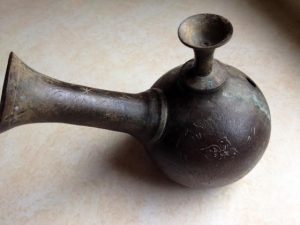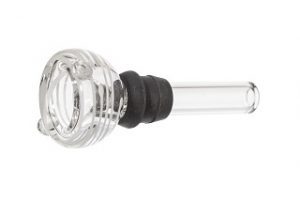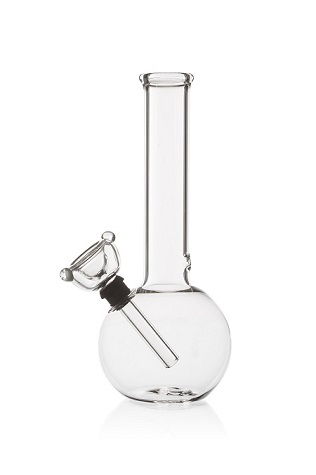Take a moment to think of the various bits of debris and detritus that a committed weed smoker will amass even in the course of a single year. Rolling papers of various sizes and flavours, grinders in plastic or metal with finely filtering crystal catching compartments, science lab-esque dabbing tools. And that’s to say nothing about the more frivolous items like rolling mats, novelty lighters and elaborately decorated baggies.
Yet one object that every seasoned cannabis aficionado is sure to own is that classic symbol of 420 culture and misspent youth – the bong. Favoured for its iconic image, social fun factor and great clean-tasting smoke, this is one implement that is here to stay. Today the humble bong, in all its various styles and incarnations, is as commonplace as the bud you smoke through it. This was not always the case, however, and today we’ll be giving you a primer on the bong and why it remains a favourite of herbalists to this day.
Origin of bongs
In a culture full of amusing names and ridiculous taglines, this simple pipe-like device remains one of the more comically named weed-related items out there. It is therefore natural to ask where it got this name and what it actually means. It may surprise some to learn that the word ‘bong’ is generally understood to come from the Thai word ‘buang’, which refers to a bamboo smoking device that was common in Central Asia centuries ago.

Where the item actually originates from is a more hotly contested topic. Trace things to before the Central Asians were puffing on their baungs and you will find evidence of smoking filtration devices being used in Africa potentially as early as the twelfth century AD. This claim is based on a find in an Ethiopian cave where 11 pipes were located, some of which were partly underground to aid their smoke cooling process.
Go even further back though and you will see that elaborate golden bongs were used by the chiefs of Scythian tribes around 400BC in present-day Russia. These were used to smoke both cannabis and opium, and the fact they were found in a kurgan (a type of ancient eastern European burial mound) suggests this probably had more of a spiritual or ritualistic purpose than a recreational one.
Naturally technology has moved things forward a little since the days of tribal leaders smoking through pipes valuable enough to pay for a piece of London real estate. Yet despite this the basic mechanics of the device are pretty much the same. Centuries ago, as today, they work by using an air and water-tight container with an open top and a pipe close to the base. Into this pipe goes whatever is to be smoked – usually tobacco or cannabis (probably better to leave the opium).
Anatomy of a Bong
The container is filled with a certain volume of water and the pipe will have its internal opening located below the water level. As you burn the contents of the pipe via the entrance of wherever they were packed you inhale from the open hole at the top.
Doing so will find you taking in a rich lungful of clean tasting smoke that most find far more pleasant and less acrid than rolling up or burning in a conventional pipe. As the device essentially acts as a filtration system it results in the inhalation feeling much cleaner and more enjoyable, which is probably the reason for its enduring popularity.
While the basics of the bong have remained the same since its birth, in recent times we thankfully no longer have to rely on animal horns and pottery to make our smoking accessories as our Ethiopian stoner ancestors did. Through the wonders of science and decades of trial and error, modern man has near-enough perfected the design of this iconic invention.
Today’s bongs are generally composed entirely of a special type of borosilicate glass. This glass is used due to its heat-resistant properties that allow the device to be used repeatedly without becoming damaged. It may not be gold, but it’s certainly more practical. Those of you who prefer your smoking device a bit more pre-industrial revolution can also find them constructed from wood or bamboo, but don’t expect them to last as long.
Apart from the basics listed above, there are plenty more components now  available on modern products that are designed to make the experience a more enjoyable one. First up is the bowl, typically a small rounded glass container that is stuck into the pipe and filled with your smoking substance of choice. This small piece of gear allows you to easily put in just the right amount to smoke and makes the lighting of it and removal of the ashes simple.
available on modern products that are designed to make the experience a more enjoyable one. First up is the bowl, typically a small rounded glass container that is stuck into the pipe and filled with your smoking substance of choice. This small piece of gear allows you to easily put in just the right amount to smoke and makes the lighting of it and removal of the ashes simple.
Secondly is the ash-catcher, another small component attached to the bottom of the pipe near the bong. Its function is, that’s right, to catch the ash before it falls from the pipe into the main filtration system. It can also add more percolation to the operation to make your hits even cooler and more pleasant.
Next up are specialised percolators themselves. Placed either outside the bong or, much like the ash-catcher, on the pipe stem, these are components designed specifically to increase the positive qualities of the experience such as getting smoother and cleaner tasting smoke. In short, they simply amplify the positive parts of using a water filtration device to light up. Finally, for the serious hobbyist we have ice-catchers – small containers in which to place ice that makes the smoke even cooler and smoother.
As you can tell then, the bong has evolved over thousands of years to become the finely honed cannabis-smoking accessory we have today. It’s true that they have their disadvantages – they’re often large, delicate and impractical to use, and maybe they do reduce some of the THC strength. Despite this, however, their continued popularity is testament to the smooth smoke, clean flavour, and downright fun experience they can provide.









